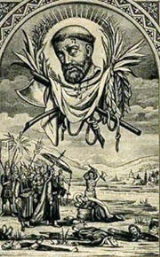
Anastasius of Persia
Encyclopedia
- Saint Anastasius redirects here. For other saints of the same name, see AnastasiusAnastasiusAnastasius is derived from the Greek ἀνάστασις meaning "resurrection". Its female form is Anastasia.-Byzantine emperors:*Anastasius I – Byzantine emperor 491–518*Anastasios II – Byzantine emperor 713–715...
Saint Anastasius of Persia (born with the name Magundat), once a member of the Zoroastrian Magi
Magi
Magi is a term, used since at least the 4th century BC, to denote a follower of Zoroaster, or rather, a follower of what the Hellenistic world associated Zoroaster with, which...
caste
Caste
Caste is an elaborate and complex social system that combines elements of endogamy, occupation, culture, social class, tribal affiliation and political power. It should not be confused with race or social class, e.g. members of different castes in one society may belong to the same race, as in India...
, became a convert of the Holy Cross
True Cross
The True Cross is the name for physical remnants which, by a Christian tradition, are believed to be from the cross upon which Jesus was crucified.According to post-Nicene historians, Socrates Scholasticus and others, the Empress Helena The True Cross is the name for physical remnants which, by a...
and was martyred in 628.
Anastasius was a soldier in the army of Khusrau II (d. 628) when that monarch carried the True Cross
True Cross
The True Cross is the name for physical remnants which, by a Christian tradition, are believed to be from the cross upon which Jesus was crucified.According to post-Nicene historians, Socrates Scholasticus and others, the Empress Helena The True Cross is the name for physical remnants which, by a...
from Jerusalem to Sassanid Persia. The occasion prompted him to ask for information; then he left the army, became a Christian, and afterwards a monk
Monk
A monk is a person who practices religious asceticism, living either alone or with any number of monks, while always maintaining some degree of physical separation from those not sharing the same purpose...
in Jerusalem. His Persian name, Magundat, he changed to Anastasius. After seven years of the monastic observance, he was moved, as he thought, by the Holy Ghost to go in quest of martyrdom and went to Caesarea, then subject to the Persians.
Reproaching his countrymen for their magic and fireworship, both of which he had once practised, he was taken prisoner, cruelly tortured to make him abjure, and finally carried down near the Euphrates
Euphrates
The Euphrates is the longest and one of the most historically important rivers of Western Asia. Together with the Tigris, it is one of the two defining rivers of Mesopotamia...
, to a place called Barsaloe (or Bethsaloe according to the Bollandists), where his tortures were renewed while at the same time the highest honours in the service of King Chosroes were promised him if he would renounce Christianity.
Finally, with seventy others, he was strangled to death and decapitated, on January 22, 628. His body, which was thrown to the dogs, but was left untouched by them, was carried from there to Palestine
Palestine
Palestine is a conventional name, among others, used to describe the geographic region between the Mediterranean Sea and the Jordan River, and various adjoining lands....
, afterwards to Constantinople
Constantinople
Constantinople was the capital of the Roman, Eastern Roman, Byzantine, Latin, and Ottoman Empires. Throughout most of the Middle Ages, Constantinople was Europe's largest and wealthiest city.-Names:...
, and finally to Rome
Rome
Rome is the capital of Italy and the country's largest and most populated city and comune, with over 2.7 million residents in . The city is located in the central-western portion of the Italian Peninsula, on the Tiber River within the Lazio region of Italy.Rome's history spans two and a half...
.
A Passio written in Greek was devoted to the saint. An adapted Latin translation, possibly by Archbishop Theodore of Canterbury, was available to the Anglo-Saxon church historian Bede
Bede
Bede , also referred to as Saint Bede or the Venerable Bede , was a monk at the Northumbrian monastery of Saint Peter at Monkwearmouth, today part of Sunderland, England, and of its companion monastery, Saint Paul's, in modern Jarrow , both in the Kingdom of Northumbria...
, who criticised the result and took it upon himself to 'improve' it. There are no surviving manuscripts of Bede's revision, though one did survive as late as the 15th century.
His feast day is 22 January.
Sources
- Saint Anastasius in the Catholic Encyclopedia
- Acta SS., 3 Jan.
- Butler, Lives of the Saints, 22 Jan.
- Laistner, M.L.W.; King, H.H. (1943). A Hand-List of Bede Manuscripts. Ithaca, NY: Cornell University Press.
Further reading
- Franklin, Carmela Vircillo. The Latin dossier of Anastasius the Persian: hagiographic translations and transformations. Pontifical Institute of Mediaeval Studies, Studies and Texts 147. Toronto, 2004.
External links
- Saint Anastasius in the Catholic Forum
- Saint Anastasiοs (Perses) from an Orthodox website

